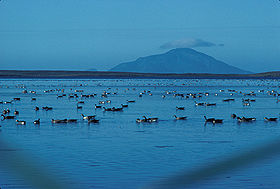- Amak Volcano
-
Amak Volcano 
Amak Island and volcano at topElevation 488 m (1,601 ft) Location Location North Pacific, part of Alaska Range Aleutian Islands Coordinates 55°25′02″N 163°08′49″W / 55.41728°N 163.14687°WCoordinates: 55°25′02″N 163°08′49″W / 55.41728°N 163.14687°W Geology Type Stratovolcano Volcanic arc/belt Aleutian Arc Last eruption 1796 Amak Volcano is a basaltic andesite stratovolcano in the Aleutian Islands of Alaska, USA, 618 miles (995 km) from Anchorage.[1] It is located on the eponymous island, 31 miles (50 km) from Frosty Volcano, near the edge of the Alaskan Peninsula's western flank. Only boats are allowed to access the island, and only with a certain permit.
Blocky (dotted with flat blocks of minerals and crystals) lava flows[2] stream from its summit to its flanks. Three historical eruptions have taken place – two within the 18th century, the first from 1700–1710, and the latter in 1796. The earliest prehistoric eruption was believed to have taken place between 3050 and 2050 BCE.
Contents
Accessibility
Cold Bay, the city nearest Amak, is easily accessible by plane. Amak is accessible only by boat; airplanes are disallowed. Private boat rides to the island are available in Cold Bay, but for access to the islands, a permit is required from the United States Fish and Wildlife Service.[3]
Geography and geology
Amak Island lies in the Bering Sea, north of the main archipelago of the Aleutians. It is one of two islands (along with Bogoslof Island) that are significantly north (31 miles (50 km))[4] of the main range.[3]
The United States has the most active volcanoes in the world, many of them geologically young.[5] In Alaska, at least 50 volcanoes, including those in the Aleutian archipelago, have erupted in historical time.[6] The state accounts for ~80% of the United States' volcanoes, excluding the seamounts in the area, ~8% of world volcanoes, and most of these are located among the Aleutian Islands.[6] The Aleutian Islands arc serves as the northern boundary of the Pacific Ring of Fire,[6] where tectonic activity generates earthquakes and volcanic eruptions in masses.
The volcano is basaltic-andesitic in composition.[3] It is a modest stratovolcano,[2] rising no more than 1,683 feet (513 m) above sea level.[1] The volcanic crater is distinct, and has erupted in historical times, only "blocky" lava flows.[2] Charles Wood and Jürgen Kienle, volcanologists, propose that earlier activity, 4,000–5,000 years ago, consisted primarily of lavas of ethereal (fine) platy and thick andesite.[3] Amak Volcano is unique in that its andesitic lavas, while composed the same as the other Aleutians, contain an abundance of potash. They also could contain more sodium carbonate and rare earth element deposits than the Aleutian norm.[4] Between Bogoslof, the other Aleutian island north of the main arc, and Amak, Amak's lavas are more alkalic and silicic.[4]
Glaciation took place around the volcano roughly 6700 years BP, carving out U-shaped valleys. At the southwest flank of the island, a crater, likely a maar, can be found amid an alluvial plain.[3]
Eruptive history
The Amak Volcano has erupted three times in historical times, in 2550 BC ± 500 years, 1700–10, and 1796; the first of these events was identified with tephrochronology. Each eruption has been characterized by lava flows, and the two most recent eruptions have included a crater eruption.[2]
References
- ^ a b "Amak description and statistics". Alaska Volcano Observatory. United States Geological Survey. http://www.avo.alaska.edu/volcanoes/volcinfo.php?volcname=Amak. Retrieved July 6, 2009.
- ^ a b c d "Amak". Global Volcanism Program, Smithsonian Institution. http://www.volcano.si.edu/world/volcano.cfm?vnum=1101-39-. Retrieved July 6, 2009.
- ^ a b c d e Wood and Kienle, p. 51.
- ^ a b c Marsh, B.D.; Leit, R.E. (November 1979). "Geology of Amak Island, Aleutian Islands, Alaska". Journal of Geology (The University of Chicago Press) 87 (6): 715–723.
- ^ Ewert, John; Guffanti, Marianne, Cervelli, Peter, and Quick, James (2006). "The National Volcano Early Warning System (NVEWS): U.S. Geological Survey Fact Sheet FS 2006-3142". United States Geological Survey. http://pubs.usgs.gov/fs/2006/3142. Retrieved July 9, 2009.
- ^ a b c Alaska GeoSurvey News: NL 2008-1. 11. Alaska Division of Geological & Geophysical Surveys. March 2008. pp. 1–14. http://www.dggs.dnr.state.ak.us/pubs/pubs?reqtype=citation&ID=16061. Retrieved July 9, 2009.
Bibliography
- Wood, Charles A., and Kienle, Jürgen, (eds.), 1990. Volcanoes of North America: United States and Canada; New York, Cambridge University Press, 354 p. ISBN 0-521-43811-X.
External links
 Media related to Amak Volcano at Wikimedia Commons
Media related to Amak Volcano at Wikimedia Commons
Categories:- Landforms of the Aleutian Islands
- Landforms of Aleutians East Borough, Alaska
- Volcanoes of Alaska
Wikimedia Foundation. 2010.
